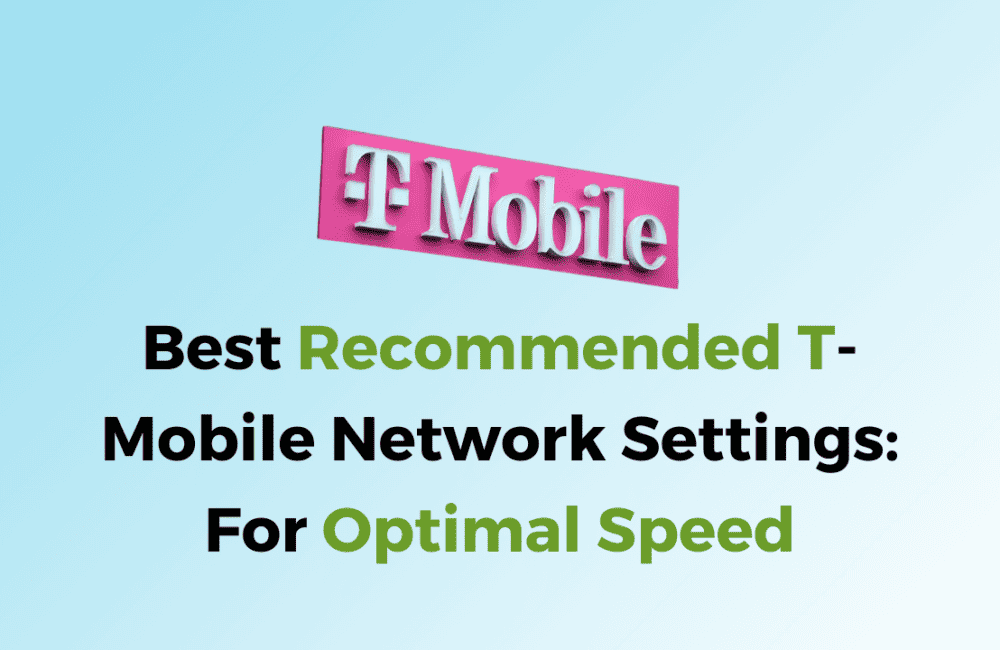If you’re a T-Mobile user, you’re probably looking to optimize your network settings for optimal speed. With the right settings, you can get the most out of your T-Mobile device and enjoy faster download and upload speeds. In this article, we’ll discuss the best recommended T-Mobile network settings to help you achieve optimal speed.
By default, your device may be set to use LTE or 5G. However, in some cases, switching to 3G may provide better coverage in areas with weak cellular signals. Choosing the right network type on your T-Mobile device can help you get the best possible speed and coverage. We’ll discuss the different network types and how to choose the right one for your device.
In addition to network type, there are other settings that can affect your T-Mobile device’s speed. We’ll cover these settings, including how to check your signal strength, how to restart your device, and how to ensure that your device is up to date with the latest software updates. With these tips and tricks, you’ll be able to optimize your T-Mobile device for optimal speed and performance.
Understanding T-Mobile Network Settings
When it comes to optimizing your T-Mobile network speed, understanding your device’s network settings is crucial. By tweaking the right settings, you can ensure that you’re getting the best possible connection and faster download and upload speeds. Here are a few key network settings to keep in mind:
Preferred Network Type
The Preferred Network Type setting allows you to choose the type of network your device will connect to. This setting can vary depending on your device model, but generally, you’ll have the option to choose between 2G, 3G, 4G, and 5G. It’s important to note that choosing a faster network type doesn’t necessarily mean you’ll get faster speeds. In some cases, a slower network type may provide a more stable connection.
APN Settings
Access Point Name (APN) settings determine how your device connects to the T-Mobile network. These settings can affect your internet speed, so it’s important to make sure they’re configured correctly. You can find your device’s APN settings in the Mobile Network section of your device’s settings. If you’re using a device that’s not sold by T-Mobile, you may need to manually enter the APN settings.
Network Reset
If you’re experiencing slow speeds or connectivity issues, resetting your device’s network settings can often help. This will reset all of your network settings to their default values, so be sure to take note of any custom settings you’ve configured before resetting. To reset your network settings, go to your device’s settings and look for the option to reset network settings.
By understanding and tweaking these key network settings, you can optimize your T-Mobile network speed and enjoy faster downloads and uploads. Experiment with different settings to find what works best for your device and location.
Optimal Settings For Speed
To get the best possible speed and coverage on your T-Mobile device, you need to adjust some settings. Below are the recommended settings for optimal speed.
4G And 5G Settings
By default, your device may be set to use LTE or 5G. However, in some cases, switching to 3G may provide better coverage in areas with weak cellular signals. To change your preferred network type on your T-Mobile device, go to Settings > Mobile Networks > Network Mode and select the appropriate option.
Another option is to enable 4G and 5G aggregation, which combines the two network types for faster download and upload speeds. To enable this feature, go to Settings > Mobile Networks > Advanced > Carrier Aggregation and turn it on.
Wi-Fi Calling And VoLTE
To ensure the best possible call quality, enable Wi-Fi Calling and VoLTE (Voice over LTE) on your T-Mobile device. Wi-Fi Calling allows you to make and receive calls over a Wi-Fi network, while VoLTE uses the 4G network for voice calls.
To enable Wi-Fi Calling, go to Settings > Phone > Wi-Fi Calling and turn it on. To enable VoLTE, go to Settings > Mobile Networks > Advanced > VoLTE and turn it on.
APN And Roaming Settings
To access the internet on your T-Mobile device, you need to configure the Access Point Name (APN) settings. To do this, go to Settings > Mobile Networks > Access Point Names and select the T-Mobile APN. Make sure the settings match the following:
| APN Name | APN | Proxy | Port | Username | Password |
|---|---|---|---|---|---|
| T-Mobile US LTE | fast.t-mobile.com | Not set | Not set | Not set | Not set |
If you’re traveling outside the US, you may need to enable roaming to access the internet. To do this, go to Settings > Mobile Networks > Data Roaming and turn it on.
By following these recommended settings, you can optimize your T-Mobile device for the best possible speed and coverage.
Advanced Network Settings
If you want to further optimize your T-Mobile network settings for optimal speed, you can try tweaking some of the advanced settings. Here are a few options to consider:
Preferred Network Type
You can adjust your preferred network type to prioritize either 5G, LTE, 3G, or 2G. To access this setting, go to your device’s network settings and select “Preferred network type.” Keep in mind that selecting a higher network type may result in faster speeds, but it may also drain your battery faster.
APN Settings
Access Point Name (APN) settings are used to connect your device to the internet. By default, your device should have the correct APN settings for T-Mobile, but you can double-check and make changes if necessary. To access your APN settings, go to your device’s network settings and select “Access Point Names.” Here are the recommended settings for T-Mobile:
| Setting | Value |
|---|---|
| APN | fast.t-mobile.com |
| MCC | 310 |
| MNC | 260 |
| Authentication Type | None |
| APN Type | default,supl,hipri |
Band Selection
You can manually select which frequency bands your device uses for data and voice. To access this setting, go to your device’s network settings and select “Network operators” or “Band selection.” Keep in mind that selecting a specific band may limit your coverage or result in slower speeds if that band is congested.
Wi-Fi Calling
Wi-Fi Calling allows you to make and receive calls over a Wi-Fi network instead of a cellular network. This can be useful if you have poor cellular coverage but a strong Wi-Fi signal. To enable Wi-Fi Calling, go to your device’s network settings and select “Wi-Fi Calling.” Keep in mind that Wi-Fi Calling may use data from your internet plan.
By tweaking these advanced network settings, you may be able to further optimize your T-Mobile network for optimal speed and reliability.



